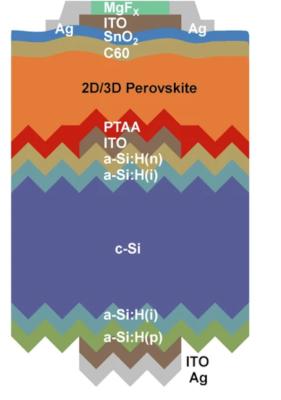Researchers from China's Beijing Institute of Technology, Peking University, Central South University, Jiangnan University and Auner Technology have developed a unique binary 2D perovskite passivation approach and used it to fabricate a monolithic perovskite/silicon tandem solar cell with a steady-state efficiency of 30.65% (reportedly assessed by a third party).
Schematic of the monolithic tandem structure based on a double-side textured silicon heterojunction cell. Image credit: Nature Communications
The tandem devices also retained 96% of their initial efficiency after 527 h of operation under full spectral continuous illumination, and 98% after 1000 h of damp-heat testing (85 °C with 85% relative humidity).
The team explained that to achieve high power conversion efficiency in perovskite/silicon tandem solar cells, it is necessary to develop a promising wide-bandgap perovskite absorber and relevant processing techniques. To date, the performance of devices based on wide-bandgap perovskite is still limited mainly by carrier recombination at their electron extraction interface.
In their recent work, the scientists demonstrated assembling a binary two-dimensional perovskite by both alternating-cation-interlayer phase and Ruddlesden−Popper phase to passivate the perovskite/C60 interface. The team proposed a strategy based on assembling 2D perovskite phases to reduce non-radiative recombination with improved charge extraction in a ~ 1.68 eV bandgap perovskite Cs0.235FA0.765Pb(I0.867Br0.133)3 with 5% MAPbCl3. Specifically, they the binary two-dimensional (B-2D) structure consisted of ACI and RP phases, and was realized by reacting a binary mixture of organic salts with 3D perovskite.
The perovskite absorbers are effectively passivated by both phases at the surface. The resultant 2D/3D heterojunction showed an n-type surface and appropriate energy level alignment, ensuring effective electron extraction and reduced carrier recombination. As a result, 1-cm2 single-junction PSCs showed a PCE of 20.95%, with a fill factor (FF) of 81.22% and open-circuit voltage (VOC) of 1.234 V.
The tandem device based on this strategy achieved a steady-state efficiency of 30.65% at an independently accredited test center of Shanghai Institute of Micro-system and Information Technology (SIMIT).
In addition, the tandem devices retained 96% of their initial performance after 527 h of operation at maximum power point (MPP) under 1-Sun illumination in air (unencapsulated device with an initial PCE of 30.34%, ~25 °C, ~25% relative humidity (RH)), and 98% after 1000 h of the damp-heat test at 85 °C and 85% RH.
The team anticipated that these findings could open new avenues for developing high-performance perovskite-based PV technologies.




